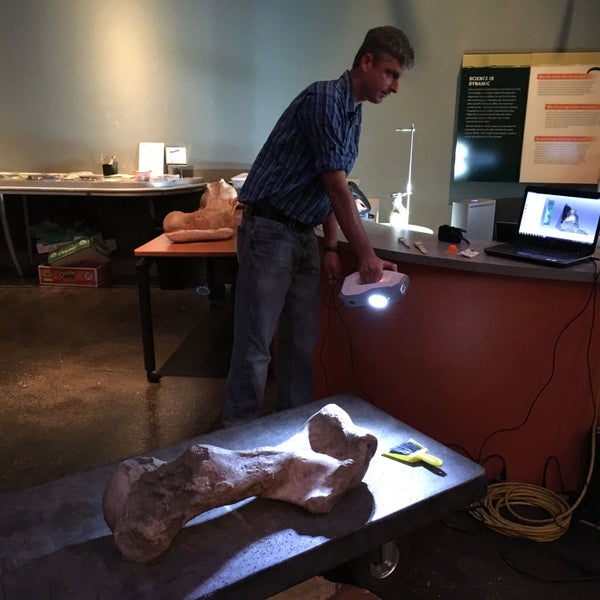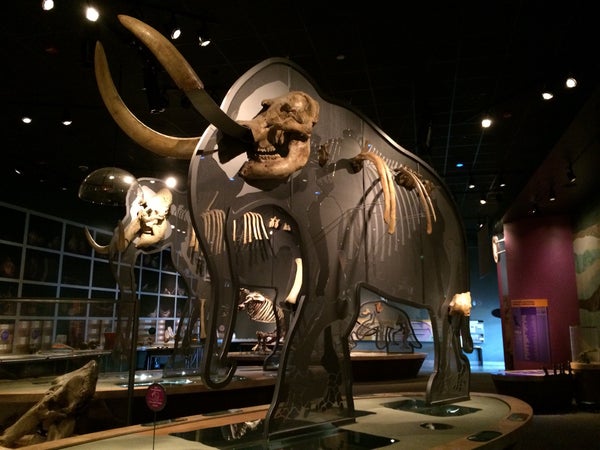This article was published in Scientific American’s former blog network and reflects the views of the author, not necessarily those of Scientific American
Not to get all hipster about it, but you probably haven’t heard of one of the most impressive Ice Age treasure troves in the country. Don’t fret. I’m not going to keep it a secret. It’s a place you could make tracks for right now if you wanted to, tucked away in southern California between LA and San Diego. The official name is the Western Science Center, built on the edge of Diamond Valley Lake in Hemet, but, to a group of paleontologists, artists, writers, and poets who gathered there earlier this month, it’s also known as the Valley of the Mastodons.
American mastodon fossils have been found from New Jersey to the Channel Islands, from the Yukon to Florida. But in the collections of the Western Science Center – uncovered, as geologist Kathleen Springer explained, during a seven-year paleontological rescue mission spurred by the construction of Diamond Valley Lake – holds an impressive number of the Ice Age beasts. More than that, the Mammut americanum found here – like Max, Lil’ Stevie, and Blaze, to name just a few of the more charismatic specimens – are different from those found elsewhere in California, not to mention the rest of the continent. That’s what led to this unconventional assemblage of conference attendees, hand-picked by paleontologists Alton Dooley and Katy Smith.
I’ve attended my fair share of paleontology conferences and dinosaur-focused shindigs before. But I’ve never encountered anything quite like what Dooley, Smith, and their colleagues pulled off for Valley of the Mastodons. There were excellent research talks, but those were only a small part of the proceedings. This was an active conference, not an endurance test of how many days I could spend glued to a folding chair in a dim auditorium. The assembled paleontologists conducted new research – making laser scans of fossils and taking new measurement of old fossils – but this was done in public, where Western Science Visitors young and old could approach the experts and ask why so many of us were obsessing over tusks and teeth. And there was the unveiling of the Valley of the Mastodons temporary exhibit itself. This was not a static collection of bones, but a set of living displays that incorporated the new insights and questions of the experts who had flown from all over the U.S. and Canada for this event. I’ve never encountered a conference quite like this before.

Paleontologist Chris Widga scans a humerus from Lil' Stevie the Mastodon. Credit: Brian Switek
But why lavish so much attention on mastodons? They’re often treated as the nerdy kids of the Ice Age, not nearly as elegant as our beloved mammoths. (If you have any doubt about this, ask which Pleistocene species researchers and the public are obsessing over bringing back through genetic wizardry. It’s not Mammut americanum.) Yet, aside from a deep affection for American mastodons among all the participants, recent research has underscored something both plain and astounding about these long lost beasts – they were real, living animals.
Let me explain. For a long time, especially in relation to why these animals went extinct, mastodons were treated as monoliths. It’s like those Facts on File cards you may have collected as a kid about modern animals – each one had a certain range, a certain diet, a certain size. But any biologist worth their degree can tell you that populations of animals differ from one another in a variety of ways. Size, proportions, color, diet, behavior. All these things vary and are the raw stuff that natural selection works on the keep changing species over time. Naturally, this applies to extinct animals as much as living ones, including mastodons.
Take teeth, for example. In his conference presentation, Dooley explained how he was initially impressed with the molars of Max, the museum’s mastodon mascot. They seemed big, and a preserved piece of Max’s femur reinforced the idea that he was a mastodon of unusual size. But when Dooley started undertaking measurements of mastodons elsewhere, he found that Max actually had relatively small molars for his body size compared to mastodons from around the country. More than that, southern California mastodons tended to have longer, more narrow molars compared to East Coast specimens.
On supporting science journalism
If you're enjoying this article, consider supporting our award-winning journalism by subscribing. By purchasing a subscription you are helping to ensure the future of impactful stories about the discoveries and ideas shaping our world today.

Paleontologist Katy Smith makes measurements of Lil' Stevie the mastodon. Credit: Brian Switek
Mastodons were not the same everywhere, a point reinforced over and over again in the conference’s public talks. Comparing the Diamond Valley Lake mastodons to East Coast specimens, for example, Smith pointed out that the DVL Mammut tend to have relatively skinny tusks when compared to individuals buried out on the East Coast. Likewise, from studies of microscopic damage to mastodon teeth, Jeremy Green pointed out that mastodons living in Ice Age Florida browsed on softer foods than their relatives elsewhere. And Grant Zazula explained that the American mastodon was not a ubiquitous, constant presence during the Pleistocene – the range of these megamammals followed the expansion and contraction of the warmer woodland environments they preferred, while colder times spread steppe that was more favorable to mammoths.
The upshot is that no single mastodon – or even population of mastodons – can be taken representative of the whole. They varied through space and time in ways that we’re really only just beginning to understand. And that figures into what we think about their extinction.
American mastodons were resilient beasts. They survived the waxing and waning of glaciers, and they were arguably better-suited to our current world than mammoths were. So why did they disappear? We still don’t know. How climate shifts may have altered their ecology is little known. And as for the idea that humans hunted them all out, the evidence just isn’t there. As paleontologist Eric Scott pointed out during his presentation, the evidence at Diamond Valley Lake, La Brea, and Tule Springs National Monument puts thousands of years between the disappearance of the mastodons and the influence of humans. Painting with broad brushes only obscures the picture.
What paleontologists are starting to assemble is a regional picture of how mastodons lived. That not only goes for the end of the Ice Age, but deep in their history. Chris Widga presented on a monster mastodon from the Gray Fossil Site in Tennessee that’s 5.8 to 4.7 million years old and has features that resemble both the classic Mammut americanum and its earlier predecessors. Exactly what this animal is has yet to be determined, but it has an important role to play in figuring out how one of my favorite Pleistocene creatures made room for itself in North America.
But a good conference raises more questions than it answers. For starters, there are matters of anatomy still waiting to be discussed. We don’t know why some American mastodons have little tusks jutting from their lower jaws and others do not. Following the conference, there’s a new effort to investigate that question. And there’s still work to do in assessing where mastodon populations existed through time. As Dooley pointed out, there seem to be No Mastodon Zones between the American Midwest and southern California. Are these real, or have we not found the necessary fossils yet?
The American mastodon is a familiar beast. It’s the animal that launched American paleontology, its bumpy molars alone spurring speculation and science about prehistory back when naturalists were only just toying with the idea of extinction as a reality. Yet we don’t really know this animal very well. We’ve been content to give them a bit of a wave and go talk to the mammoths instead, impressed by the more regal stature of Mammuthus. I’m glad that’s changing. In scientific conversation, we’ll not only learn about the lives of the big and shaggy, but how dramatically and quickly our world can change. As goes the mastodon, so goes the Ice Age.
The Valley of the Mastodons exhibit, featuring the largest number of American mastodon fossils put on display, can currently be seen at the Western Science Center.
The Western Science Center graciously provided lodging, food, and transportation costs for me to attend this conference, and I am thankful to Alton Dooley and Katy Smith for their invitation.
